PinotFile: 9.32 October 26, 2013
|
Sta. Rita Hills 2013 Wine and FireI attended the Fourth Annual 2013 Wine and Fire event in the Sta. Rita Hills sponsored by the Sta. Rita Hills Winegrowers Alliance (SRHWA). The SRHWA was organized in 1997 to unify wineries and growers in the Western Santa Ynez Valley and develop an American Viticultural Area. Spearheaded by Richard Sanford, Bryan Babcock, Rick Longoria, Wes Hagen, and other local wine personalities, the Alliance gathered the information necessary to submit an AVA petition in late 1997. The AVA designation was granted in 2001, and today, the Alliance includes 48 vineyard and winery members including wineries that source grapes from the Sta. Rita Hills AVA and local industry related businesses.
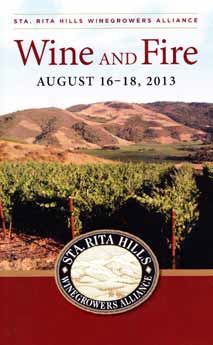 The Sta. Rita Hills AVA is a western subdivision of the much larger Santa Ynez Valley AVA and occupies 30,720 acres. Originally named the Santa Rita Hills, local vintners were prevented from using that name by Vina Santa Rita, a 123-year-old winery in Santaigo, Chile, and the name Sta. Rita Hills was adopted in 2005. Sta. Rita Hills is pronounced the same as Santa Rita Hills. The Sta. Rita Hills AVA is one of the few wine regions along the California Coast where the mountains run east-west instead of north-south. Due to tectonic plate movements, mountains originally rose out of the ocean in a north-south orientation along the California Coast. Over a time span of twelve million years, mountains in the Sta. Rita Hills region broke from the plate and turned clockwise, creating the most clearly delineated transverse range from Alaska to Chile on the Pacific Coast. The result is a maritime alley that allows cooling Pacific Ocean winds to flow inland. When it is hot in Santa Ynez which is ten miles to the East, it is ten degrees cooler in the western Sta. Rita Hills. Fog hovers over the vines until mid morning, daily ocean breezes cool the vines, and the temperature barely rises above 75 degrees in the western reaches of the AVA. There are two soils types in the Sta. Rita Hills. The soils along Santa Rosa Road are diatomaceous (soft, siliceous sedimentary rock), clay and shale, while the soils along Highway 246 are sand with deposits of diatomaceous earth. In both corridors, the maritime influence combined with the calcareous soils make this AVA ideal suited for growing Pinot Noir and Chardonnay. The growing season is among the longest in California (March through October). The region has a long history of winegrowing. In 1787, the Mission grape was planted by Franciscans as they established La Purisma Conceptción at the western edge of the AVA. Vestiges of Mission grape plantings can be seen at Gypsy Canyon where gnarled vines that are well over 100 years old remain productive. The first modern vineyard in the Sta. Rita Hills, Sanford & Benedict, was planted in 1974. By 1997 there were 14 vineyards totaling just over 500 acres, but the current total is more than 55 vineyards totaling about 2,800 acres. The vineyards, primarily planted to Pinot Noir and Chardonnay with smaller amounts of eighteen other wine grape varieties, are scattered about two east-west oriented valleys limited by Santa Rosa Hills on the South and the Purisima Hills on the North and centered along Santa Rosa Road (Santa Rosa Corridor) and Highway 246 (Santa Rita Hwy 246 corridor). Refer to the map of the Sta. Rita Hills AVA below for the location of vineyards.
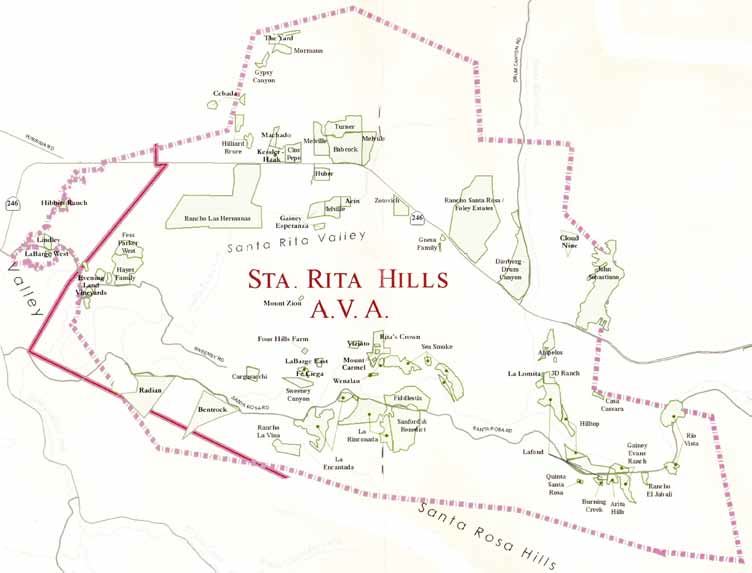 The Wine and Fire event featured a Friday night Barn Party at Sanford & Benedict Vineyard, the site of the first vineyard and winery in the Sta. Rita Hills. Saturday’s events began with a morning seminar at Hilliard Bruce Vineyard and Estate with lunch catered by The Hitching Post II. The Grand Tasting Saturday evening was held on the grounds of the historic La Purisima Mission, just outside of Lompoc featuring 25 SRHWA members pouring current releases of Pinot Noir, Chardonnay and other Sta. Rita Hills wines. The entire weekend also offered winery open houses, focused tastings and winery events. I plan to concentrate this report on the Saturday morning “Treasures of the Sta. Rita Hills” seminar hosted by Josh Raynolds of Stephen Tanzer’s International Wine Cellar. Thirteen Sta. Rita Hills producers presented a virtual tour of thirteen vineyards of the Sta. Rita Hills. The seminar was divided into a Chardonnay panel and a Pinot Noir (Clone 115) panel, and each discussion was split into vineyards of the Santa Rosa Corridor and those of the Santa Rita Hwy 246 corridor.
Sta. Rita Hills Chardonnay Vineyards(Pass the Acid Test)Sta. Rita Hills has almost become synonymous with Pinot Noir, but the region is equally suitable for Chardonnay. Jay MacInerney wrote in the Wall Street Journal (“Radical Chardonnays: Santa Barbara winemakers are taking Cali chards in crisp new directions,” May 22-23, 2010) “The hottest area for Chardonnay, the Santa Rita Hills, is an appellation that came into existence only in 2001. Actually it’s not so much hot as it is cool, which gives these Chardonnays a crispness that’s missing from so many California Chards. The first time I tasted a Chardonnay from the Santa Rita Hills, I was baffled. On the one hand, it was very ripe and fleshy, and on the other, it had a bracing acid-slap that I associated with cool climate whites and even a mineral note, which you seldom find in New World wines. It was a little like meeting Jessica Simpson, only to have her start speaking perfect French in Carla Bruni’s voice.” The acid-driven Chardonnays from the Sta. Rita Hills are more steely, mineral-infused, crisper and brighter than many California Chardonnays. They are more akin to French white burgundies, but with riper and richer fruit and more alcohol. The high acidity keeps the typically elevated alcohols in balance and the balance makes these good food wines. Acidity was a major topic of discussion at the seminar. Malolactic fermentation, a secondary fermentation in which harsher malic acid is converted to softer lactic acid, is the major contributor to the creamy mouthfeel many consumers prefer in Chardonnay. If a Chardonnay is not put through complete malolactic fermentation, the residual malic acid sticks out, leaving the wine with an angular malic bite, but preserving more fruit character, offering less secondary buttery characters, and more age ability. Malolactic fermentation is performed by Lactobacillus bacteria. If a Chardonnay is not put through full malolactic fermentation either by inoculation or natural means, one of two procedures must be done to insure that the wine does not undergo malolactic fermentation and/or other spoilage in the bottle: adding the preservative dimethyldicarbonate (Velcorin) or sterile filtration. How do you tell if a Chardonnay has undergone no malolactic fermentation, partial malolactic fermentation or 100% malolactic fermentation? The best clue is the word “unfiltered” on the label, which indicates the wine has probably undergone full malolactic fermentation. The plantings of Chardonnay in the Sta. Rita Hills include both heritage (Hyde, Wente, Mount Eden) and Dijon (75, 76) clones. Most of the plantings are less than fifteen years old, while the oldest Chardonnay vines at Sanford & Benedict Vineyard and Sweeney Canyon Vineyard go back over thirty years.
Chardonnay: Santa Rosa CorridorSweeney Canyon Vineyard Represented by Steve Clifton of Brewer-Clifton Winery: 2010 Brewer-Clifton Sweeney Canyon Sta. Rita Hills Chardonnay, 15.2% alc., $40. The Marks family still own and farm this 18.5-acre Chardonnay and Pinot Noir vineyard that was first planted in 1980. Three generations of the Marks family have worked Sweeney Canyon Vineyard. The property is located along the Santa Ynez River channel to the west of Mount Carmel Vineyard and immediately to the east of Cargasacchi Vineyard. The original Chardonnay plantings are own-rooted Wente clone and the vines are dry farmed. Wines from this vineyard tend to be rich and complex and age extremely well. Golden yellow color and clear in the glass. Aromas of lemon, lime, white stone fruits, spice and roasted nuts. Rich, concentrated flavors of grilled yellow peach, lemon and burnt caramel with a viscous texture and excellent background acidity. This wine is true to the Brewer-Clifton house style of 100% malolactic fermented, oak aged Chardonnay.
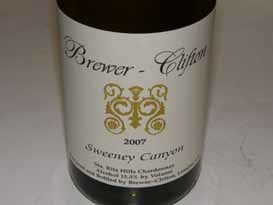 Note: Sweeney Canyon Vineyard also produces Chardonnay (both barrel fermented and unoaked bottlings) and Pinot Noir under its own label, vinified by Kristi Marks.
Rita’s Crown Vineyard Represented by Ken Brown of Ken Brown Wines: 2011 Ken Brown Rita’s Crown Vineyard Sta. Rita Hills Chardonnay, 14.3% alc., pH 3.37, TA 0.64, 67 cases, $42. Rita’s Crown Vineyard was planted in 2007 and is one of the newest vineyards in the Sta. Rita Hills AVA. The property is located at an elevation of 600 to 950 feet on a dramatic southwest facing slope at the “crown” of the Santa Rita Hills. Sitting above Sea Smoke, La Rinconada, Sanford & Benedict and Fiddlestix, it is one of the highest planted vineyards in the AVA, and the elevation makes this site particularly vulnerable to coastal fog and cool marine winds from the nearby Pacific Ocean. The soils are sandy loam with ancient seashell deposits, contributing to the hallmark minerality in the wines. The block used for this Chardonnay is planted to Dijon clone 76 on 101-14 rootstock. The wine was 100% barrel fermented with 70% malolactic fermentation, aged 11 months sur lie in 17% new French oak barrels. This wine is the inaugural bottling from this vineyard. Ken Brown is one of Santa Barbara County’s most veteran winemakers, with a history dating back to 1977. Light golden yellow color and clear in the glass. Nicely perfumed with aromas of lemon tart, white peach, almond skins, and sea brine. Delicious and creamy on the palate, with flavors of lemon curd, peach cobbler, tropical fruits and complimentary oak highlights. An outstanding, very classy and well-crafted wine that is quintessential Sta. Rita Hills Chardonnay.
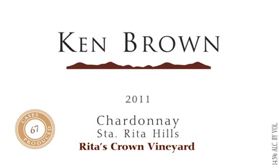 Note: Ken almost offers a superb Chardonnay from the Nielson Vineyard, planted in 1964 by pioneer Uriel Nielson, making it Santa Barbara County’s oldest vineyard. This property has been replanted using cuttings from the original vines which included the Wente clone. Only 138 cases produced in 2011.
Rancho El Jabali Vineyard Represented by Richard Sanford of Alma Rosa Winery: 2011 Alma Rosa El Jabali Vineyard Sta. Rita Hills Chardonnay, 14.74% alc., pH 3.36, TA 0.62, 190 cases, $28. Rancho El Jabali (Ranch of the Wild Boar) is owned by the Sanford family and is located in the southeastern corner of the original 1839 Mexican Land Grant known as Rancho Santa Rosa. The site has been the Sanford’s home since 1982. The 7-acre vineyard was planted in 1983 to 3.5 acres of Pinot Noir (Mount Eden clone) and 3.5 acres of Chardonnay (Wente clone). The well-drained gravelly clay loam soils are primarily Pleistocene river terrace marine deposits. Medium golden yellow color and clear in the glass. Aromas of lemongrass, ripe apple and oak vanillin lead to pleasing flavors of an array of citrus fruits blessed with supportive oak notes. Clean, pure and slightly creamy, the wine is driven by well-integrated lively acidity. A beautiful reflection of Sta. Rita Hills terroir at a very reasonable price.
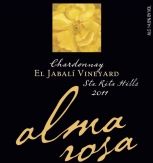
Hilliard Bruce Vineyard Represented by Christine Bruce of Hilliard Bruce: 2010 Hilliard Bruce Estate Sta. Rita Hills Chardonnay, $45. Hilliard Bruce is a spectacular property consisting of a 21-acre vineyard planted to 15.7 acres of Pinot Noir (Calera, Pommard, 115, 667, 777) and 5.3 acres of Chardonnay (Dijon clones 76 and 96). The SIP Certified Sustainable planting density is 6’ x 3’ with 2420 vines per acre. All irrigation water is pretreated to reduce alkaline biocarbonates, heavy metals and excess nutrients. The water status of the vines is monitored with Fruition Sciences sensors installed inside the trunks of several vines which, along with the weather station located in the vineyard, are connected to the internet. Compost is made on site by static aeration in a compost building designed by O2 Compost and the University of Washington.
You would hard pressed to find another vineyard in the world that is so impeccably farmed with perfectly trellised vines and precise watering mechanisms as the Hilliard Bruce Vineyard. The owners, John Hilliard and Christine Bruce are former artists (in visual art and music, respectively) and master gardeners and the property shows it. The 101-acre ranch was purchased in 2002. Christine, a successful Arabian horse breeder, and John, who had just undergone a second kidney transplant, had been looking to relocate their farm from their native Texas to California. Christine needed a place she could raise her horses, and John, a wine lover, was determined to pursue his dream of cultivating a vineyard. The vineyard was planted under the guidance of Tom Prentice. The vines are surrounded by 80 acres of native oaks, rambling botanical gardens featuring exotic palm and date trees, espaliered apple trees, and beds upon beds of vegetables, tubers, lettuces and herbs. Over 500 varieties of roses are found throughout the ranch. Two full-time landscape workers and two full-time vineyard workers insure the property is meticulously maintained. John and Christine have learned winemaking through courses at the University of California Davis Extension Program and the Allan Hancock Viticulture and Enology Program, and have had two consulting winemakers, Peter Work and Paul Lato. By harvest 2014, all Hilliard Bruce wines will be produced in a new LEED-certified winery on site. An underground cellar will be humidity controlled, the barrel room will have temperature-controlled sections, and the contemporary structure will featuring 120-foot-wide by 2.5-story-tall glass windows creating a soft glow on the hillside at night. The completed winery will feature a demonstration kitchen and dining room and a tasting area. Tours and tastings are currently available by appointment only and are often guided by John and Christine. To set up a visit, call 305-979-2601 or consult www.hilliardbruce.com for more information. The single estate Chardonnay is kept on its lees for 16 months in 30% new French oak barrels before being racked into a tank for cold stabilization before bottling. Moderately light golden yellow color and clear in the glass. This wine offers a compatible marriage of lemon, peach, baked pear, spice and oak aromas and flavors. There is an appealing acid-driven crispness and salinity as well. Very high quality stuff.
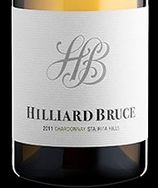 Rancho Santa Rosa Vineyard Represented by Leslie Mead Renaud, winemaker for Foley Winery: 2011 Foley T Anchor Ranch Rancho Santa Rosa Vineyard Sta. Rita Hills Chardonnay, 14.7% alc., pH 3.19, TA 0.75, 390 cases, $45. Rancho Santa Rosa is an historic property that formerly was a thoroughbred horse ranch. Bill Foley established 230 acres of vineyards on the 460-acre property which is subdivided into 59 micro blocks that are farmed, harvested and vinified separately. Pinot Noir was established on the south facing, highest reaches of the ranch with elevations to 1000 feet, while Chardonnay (clones 76, 96, and Wente) was planted on the rolling hills surrounding the winery. 8 acres of Syrah are planted on the western corridor. 2002 marked the inaugural release from this vineyard. This particular Chardonnay is from a noteworthy site within the Rancho Santa Rosa Vineyard. It was aged 18 months in 40% new French oak barrels. Moderately light yellow color and clear in the glass. The nose is flush with aromas of lemon peel, spice and a hint of toasty oak. On the palate, the wine is crisp and juicy with satisfying flavors of lemon and white peach with beautifully integrated oak highlights. The underlying cut of acidity leads to a steely, refreshing, and palate cleansing finish. Outstanding.
3-D Vineyard Represented by Antonio Moretti of Moretti Wines: 2011 Moretti 3-D Vineyard Sta. Rita Hills Chardonnay. 3-D Vineyard is owned by Tom and Jan Davidson and farmed by Brewer-Clifton. Situated between Lafond and Ampelos vineyards, this 10-acre vineyard is planted to equal amounts of Wente 4, Hyde, Mount Eden, Sea Smoke Wente and Dijon 76 clones of Chardonnay. Moretti Wines owners Antonio and Jeni Moretti have over 35 years of wine business experience between them. Steve Clifton is the winemaker. This wine underwent 30% malolactic fermentation with no new oak elevage. Moderate golden yellow color and clear in the glass. Ripe fruit nose featuring aromas of tropical fruits, grilled lemons and butter. Rich, fat and fruity with some tannic astringency, a bite of acidity and a little heat on the finish. Note: Brewer-Clifton also produces a 3-D Vineyard Chardonnay. Other Sta. Rita Hills Chardonnay producers I can recommend: Sea Smoke, Clos Pepe, Melville, Longoria and Seagrape Wine Company.
Sta. Rita Hills Pinot Noir Vineyards - Clone 115(Call Me Dependable)
All wines were 2012 barrel samples (a poor choice in my opinion as the wines were very young and challenging to evaluate). Each wine was 100% clone 115 and 100% de-stemmed except the Siduri which was 15% whole cluster. 2012 was a high quality, more forward vintage. Dijon Pinot Noir clones have been planted widely for over thirty years in California and Oregon with clone 115 being the most extensively planted Dijon clone. 115 produces small, tight clusters like little hand grenades, regular yields, strong purple color, high anthocyanin, high pH, notable tannins, and a varietally consistent aromatic profile of black cherries, leather and roses, and compelling flavors of cherries, blueberries, boysenberries and anise. Clone 115 is one of the few (777 the other) Dijon clones that makes an excellent and complete wine on its own and is valued for its balance, aromatic profile and its ability to be a consistent producer in various locations. Reportedly, wines made in France at the Lycée Viticole from clone 115 have placed at or near the top of their evaluations until clone 943 came along.
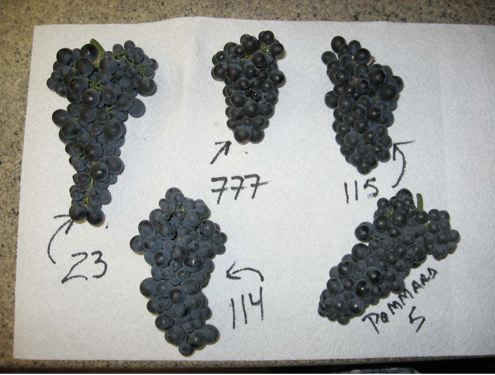 Cargassachi Vineyard Represented by Brandon Sparks-Gillis of Dragonette Cellars: 2012 Dragonette Cellars Cargassachi Vineyard Sta. Rita Hills Pinot Noir. Cargassachi Vineyard is located off Sweeney Road at the far western edge of the Sta. Rita Hills AVA. The 12 acres are planted to clone 115 on two different rootstocks: 3309C and 420A. Soil type is Botella Series, a combination of clay and loam with a fairly high calcareous content which drains well and helps to moderate yields. Medium reddish-purple color in the glass. The nose is savory with notes of dark red berries and briar. Middleweight flavors of blueberries and black raspberries with a savory herb underpinning. Still tight, but the underlying acidity and pleasing finesse are quite evident.
Rancho La Viña Vineyard Represented by Kris Curran of D’Alfonso Curran: 2012 D’Alfonso Curran Rancho La Viña Sta. Rita Hills Pinot Noir. Rancho La Viña is a family owned and operated ranch that is a 2,800-acre remnant of the Santa Rosa Land Grant purchased in the 1860s. The owners also grow walnuts and tomatoes on the property. The vineyard is at the far western edge of the Sta. Rita Hills AVA. 17.2 acres were planted in 2005 on a gently sloped mesa that is several hundred feet above the valley floor. The site is fully exposed to the cool winds coming off the Pacific Ocean making it one of the coldest Pinot Noir plantings in California. The windy location along with low fertility soils result in deep, dark and intense flavors. Clones are 115, 667, 777 and 2A grafted on 101-14 and 110R rootstocks. Vine spacing is 7’ x 4’ for a planting density of 1,556 vines per acre. The first year of production was 2007. This wine was aged in neutral barrels and underwent partial malolactic fermentation. Medium reddish-purple color in the glass. Enticing aromas of boysenberries and spice which are duplicated on the palate. Fruit forward and soft in the mouth with a wow finish. Outstanding potential. Everyone’s favorite at this tasting.
Rancho La Rinconada Vineyard Represented by Steve Fennell of Sanford Winery: 2012 Sanford La Rincanada Vineyard St. Rita Hills Pinot Noir. Sanford Winery’s 438-acre ranch has 146 acres under vine, primarily Pinot Noir (60 acres) and Chardonnay (70 acres). The La Rincondada Vineyard sits on a well-drained, west facing hillside with 9%-15% slopes. The soil type is Santa Lucia shaley clay loam. Heavy Pacific fog regularly pools in this valley vineyard. A tasting room on the property offers 360-degree views of the vineyard. Moderate reddish-purple color in the glass. Hard to evaluate this wine because it was recently sulfured and sulfur permeated the nose and palate.
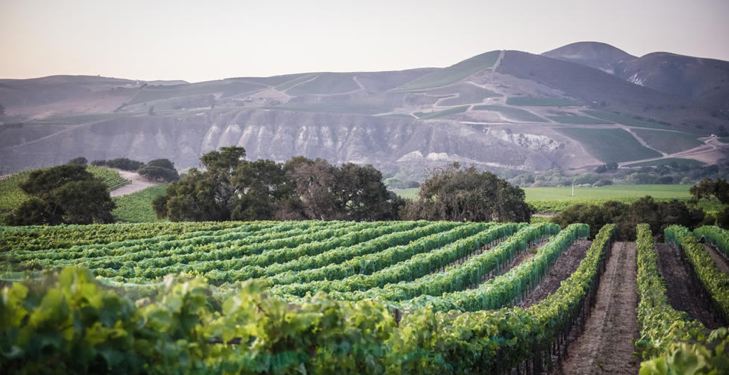 Rio Vista Vineyard Represented by Norm Yost of Flying Goat Cellars: 2012 Flying Goat Cellars Rio Vista Vineyard Sta. Rita Hills Pinot Noir. Rio Vista Vineyard is the eastern most vineyard planted entirely within the Sta. Rita Hills AVA. Because of its location, it is also the warmest site. The property was planted and is meticulously farmed by John Belfry of Buona Terra Farming. There are three different vineyards making up Rio Vista. Rio Vista Vineyards North and South (located east of Santa Rosa Road) were planted in 2000 and the third vineyard (located west of Santa Rosa Road) was planted in 2006. The dominant soil series is limestone, sedimentary with a marine layer of sandy loam. Flying Goat sources clones 2A, 115, 667 and 777 and produces three clonal-designate wines including clone 2A, clone 667 and a Dijon clone blend. Moderately light reddish-purple color in the glass. Aroma of slightly confected cherries with lighter weight flavors of red cherries, red berries and spice. Bright and vivid, finishing with burst of Maraschino cherry goodness.
Kessler-Haak Vineyard is located in the northwestern section of the Sta. Rita Hills AVA and is one of the colder
microclimates in the region with frost being a frequent visitor in the spring and occasionally in the fall before
harvest. The vineyard was planted in 2005 to seven Pinot Noir clones on three rootstocks amongst 27 acres of
the vineyard’s rolling hillsides. A 2.5-acre east facing hillside was planted to three clones of Chardonnay.
Yields are very low, averaging 1.2 to 1.5 tons per acre for Pinot Noir and Chardonnay. La Montagne (“The
Mountain”) produces very limited production wines under the direction of winemaker Kimberly Smith who was
mentored by Clos Pepe’s Wes Hagen. Her first vintage was 2010. Moderately light reddish-purple color in the
glass. Very young and primary but showing a peek of greatness with aromas and flavors of fresh, vivid red
fruits wrapped in supportive grainy tannins.
Clos Pepe Vineyard Represented by Adam Lee of Siduri Wines: 2012 Siduri Clos Pepe Vineyard Sta. Rita
Hills Pinot Noir.
Clos Pepe Vineyards dates to 1994 when Steve and Catherine Pepe bought a 40-acre horse ranch in the
center of the current Sta. Rita Hills AVA. Guided by noted vineyard consultant, Jeff Newton of Coastal Vineyard
Care, the first half of the vineyard was planted in 1996. Wes Hagen took over full winemaking and managerial
duties in 1998, and designed and planted the last 14 acres. The site is blessed with wind, fog, low
temperatures and sea bed soils that intensely limit vigor. Moderately dark reddish-purple color in the glass.
Shy aromas of berries and plum with rich flavors of well-ripened blueberries. The purity of the fruit shines
through and a little earthiness adds interest. Exceptional, even extraordinary potential here.
Sebastiano Vineyard Represented by Bill Wathen of Foxen: 2012 Foxen Sebastiano Vineyard Sta. Rita
Hills Pinot Noir.
Sebastiano Vineyard lies at the eastern edge of the Sta. Rita Hills AVA and is not wholly
contained within the AVA. It is composed of 41 blocks and nine Pinot Noir clones totaling 91 acres within the
Sta. Rita Hills AVA. The 60 acres outside the AVA border are planted to Syrah, Grenache, Chardonnay and
other wine grape varieties. Established in 2008, Sebastiano Vineyard is managed by Coastal Vineyard Care.
Medium reddish-purple color in the glass. Hard to evaluate this wine due to an overlay of sulfur on the nose
and palate. The core features red fruits with a zippy, acid-driven finish.
The Sta. Rita Hills Winegrowers’ Alliance includes the following member wineries. Tasting rooms are located at
some of the wineries, in the town of Lompoc and the “Lompoc Wine Ghetto,” and in Buellton, Solvang, Santa
Ynez and Los Olivos. Visit the SRHWA website at www.staritahills.com for specific tasting room locations and
hours.
<>
Alma Rosa Winery & Vineyards
Other wineries producing wine from Sta. Rita Hills vineyards that are worth consideration include Ampelos
Cellars, Arcadian, Babcock Winery, Bonaccorsi, Domaine de la Côte, Inception, Lutum, Melville Vineyards &
Winery, Paul Lato, Rusack Vineyards, Samsara, Sandhi Wines, Tensley, and Westerly Wines.
Siduri Wines Shine in 2012Winemaker Adam Lee of Siduri Wines told me, “2012 is a winemaker’s dream and a wine writer’s nightmare because nothing exceptional happened.” It has been jokingly called the “Goldilocks Vintage,” because it was not too hot and not too cold. The growing season was moderately warm without excessive heat spikes. The result is dreary wine writing but really good wines. In 2012, bud break, flowering, set and harvest were generally on time. Yields were remarkably large, especially in the Russian River Valley and Sonoma Coast, and only slightly larger than normal in the Santa Lucia Highlands and Sta. Rita Hills. Yields in Oregon were below normal, but the quality of the fruit was extremely high. The result was that Adam did quite a bit of bleed off (saignée) particularly in Sonoma County, varying anywhere from 10% to 25% depending on the lot. Generally acids were in line and Adam felt comfortable doing a slightly higher percentage of whole cluster on the ferments. He did inoculate more than usual, mainly late in the season as he was running out of room. A number of 2012 wines were ready to go and bottled in August but some have been kept back until January for bottling. The wines are gluten free and vegan friendly. All wines are bottled under screw cap closure. Overall the 2012 Siduri Pinot Noirs show more flesh than in 2011 and are quite inviting at this young age. Still, the vineyard-designated wines will benefit from another 6 to 12 months in bottle. Some of the vineyard-designated wines are stunning in 2012. The new labels for the 2012 vintage are very classy.
2012 Siduri Willamette Valley Pinot Noir 14.1% alc., 1,034 cases, $22. · Moderately light reddish-purple color in the glass. The nose is appealing and picks up interest over time in the glass offering aromas of candied cherries, rose petals and pie spice. An Oregon-styled wine with mid weight flavors of tart cherries and cranberries, mild tannins, and a tight, hi-pitched finish. Score: 87
2012 Siduri Shaw Mountain Vineyard Pinot Noir 14.35% alc., pH 3.55, TA 0.62, 75 cases, $39. Vineyard owned by Ralph and Marlene Shaw and managed by Bob Grimes. The vineyard has been inconsistent over the past dozen years, but was stellar in 2012. Aged in 66% new French oak barrels. Unfined and unfiltered. · Moderately dark reddish-purple color in the glass. Interesting aromas of dark berries and plums with hints of pine forest, wood box, and tea leaf. Discreetly concentrated and flavorful exhibiting an array of fruits including ripe strawberry, black raspberry and pomegranate. The oak is supportive but not intrusive, the tannins are modest and the finish has a burst of palate cleansing acidity. I like this wine for its acid-driven vigor. Score: 88
2012 Siduri Russian River Valley Pinot Noir 14.1% alc., 3,575 cases, $32. · Moderate reddish-purple color in the glass. This wine is Russian River Valley Pinot Noir personified with plenty of appealing Bing cherry, rose petal, tea and dark chocolate aromas on the nose, and a judicious core of Bing cherry, spice and cola flavors on the palate. The tannic backbone is supple, oak is nicely integrated, and there is enough uplifting acidity to bring the fruit to life. Score: 88
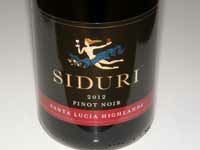 2012 Siduri Santa Lucia Highlands Pinot Noir 14.5% alc., 3,019 cases, $32. · Moderately dark reddish-purple color in the glass. The nose is flush with black cherry, black raspberry, anise and spice perfume. Dark fruits including blackberry and plum fill the mouth with flavor that persists on the finish. The wine has the typical structural muscle shown by wines from this region. A solid, fruit-driven offering that aims to please. Score: 88
2012 Siduri Bucher Vineyard Russian River Valley Pinot Noir 13.69% alc., pH 3.73, TA 0.60, 100 cases, $44. Inaugural release from this vineyard located on Westside Road. Owned by John and Diane Bucher, the Bucher Vineyard is on a hillside with various aspects. Grapes were harvested at moderate levels of sugar over a two week window. The lots were fermented separately. Half of the wine came from the newest section of the vineyard (“Forklift” Block) which produced the wine with the greatest concentration and interest. Unfined and unfiltered. · Moderately dark reddish-purple color in the glass. Intense aromas of black cherries, grilled peach and toasty oak. Succulent and sappy on the palate with plenty of black cherry goodness, carrying a tarry, earthy, even barnyard undertone that Burgundy lovers may relish. Easy to drink, with finishing intensity. Score: 88
2012 Siduri Keefer Ranch Russian River Valley Pinot Noir 14.59% alc., pH 3.53, TA 0.63, 517 cases, $52. From six separate sections of the vineyard. Each section was treated differently, using whole clusters on some but not on others, adding yeast to the must on some, but not on others, etc. The ultimate blend includes five out of the six sections. Clones are Pommard, 2A, 777, 115 and 114. Unfined and unfiltered. · Moderate reddish-purple color in the glass. Lovely aromas of fresh cherry pie glaze, baking spices and sandalwood. The delicious and seductive core of juicy iced cherry and red berry flavors is wrapped in gossamer tannins. Beautifully composed and harmonious with a refreshing finish of cherry goodness. Keefer Ranch terroir really shows through in this wine. Score: 94
2012 Siduri Pratt Vineyard-Sexton Road Sonoma Coast Pinot Noir 14.66% alc., pH 3.60, TA 0.63, 282 cases, $48. 25% whole cluster in the Pommard section of the vineyard. Other clones include 777 and 23. Unfined and unfiltered. · Medium reddish-purple color in the glass. This is the kind of Pinot perfume that drives pinotphiles crazy. Uplifting aromas of cherry latté, spiced Halloween punch, and black raspberry preserves lead to a delicious core of sappy black raspberry, black plum and spice flavors. Mouth coating from entry to finish with complimentary oak highlights. A pleasure nest. Score: 94
2012 Siduri Sierra Mar Vineyard Santa Lucia Highlands Pinot Noir 15.27% alc., pH 3.66, TA 0.65, 444 cases, $52. Each section picked at ideal ripeness with harvest spread over a month’s time. Each clone (943, 23, 777 and Pommard) was fermented individually, with winemaking treatment varying depending on the fruit condition. A bit more whole cluster than in previous years. Unfined and unfiltered. · Moderately dark reddishpurple color in the glass. Nicely perfumed with aromas of Bing cherries, red rose petals and potpourri. Mouth watering flavors of peak-ripened fruits including black cherry, black raspberry and strawberry. Very smooth and seductive on the palate with welcoming concentration, finishing with a pleasing burst of robust fruit flavor. The wine picks up interest and intensity over time in the glass and the balance is spot on, portending a long life ahead. Score: 93
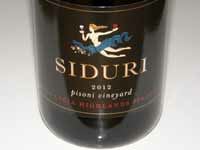 2012 Siduri Pisoni Vineyard Santa Lucia Highlands Pinot Noir 14.9% alc., pH 3.53, TA 0.68, 423 cases, $55. First single-vineyard Pinot Noir release from the 2012 vintage. Sourced from three sections of the vineyard which were fermented separately. Some whole cluster in two of the three sections. The final blend included 37% of the barrels, a strict selection not driven by profit but by quality. Unfined and unfiltered. · Dark reddish-purple color in the glass. Intoxicating aromas of dark red and black cherry berry mix with a hint of oak vanillin. Delicious, intense flavors of dark berries and black plums, nicely spiced with a lush, long finish. The darkest fruited, most tannic, and most powerful wine in the 2012 Siduri lineup. When this wine enters your mouth, the experience is scintillating. If this wine doesn’t make the hairs stand up on the back of your neck, you must be undead. A distinctive wine that is tré Pisoni. Score: 95
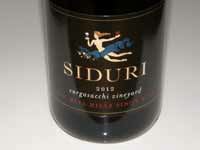 2012 Siduri Cargassachi Vineyard Sta. Rita Hills Pinot Noir 14.69% alc., pH 3.53, TA 0.68, 211 cases, $52. 100% clone 115. Vineyard picked in two sections giving a mix of flavor profiles. Unfined and unfiltered. · Dark reddish-purple color in the glass. The nose is quite typical of this vineyard with aromas of black berry and stone fruits, black currant, mesquite, iron and earth. Plush, soft, rich and inviting on the palate, this wine offers a mouthful of earth-kissed purple and black fruits perfectly matched to ripe tannins. The intense, grandiose, and aromatic finish is full of juicy fruit pleasure. Wines from this vineyard can be somewhat animale in character and brooding, but this wine sparkles with freshness and vibrancy as well as offering inviting finesse with power. The best Cargassachi Vineyard Pinot Noir I have ever tasted. Scary to think this will get better with more time in bottle. Score: 94
Sips of Recently Tasted California WinesThe wines from Bailiwick in 2011 are all well-crafted, but overall lack the extraction, intensity and excitement of the previous vintage. I believe they will pick up more weight and interest with another year or two in bottle. Winemaker Paul Vais told me they have been able to significantly lower their prices in this vintage due to an increase in production efficiencies. Visit www.bailiwickwines.com.
2011 Bailiwick Borderline Marin County Pinot Noir 14.1% alc., pH 3.71, TA 0.64, 225 cases, $28. Sourced from Kendric and Chileno Valley vineyards which lie along the southern edge of the Petaluma Gap. Clones 777 and 667. 100% de-stemmed, post-fermentation maceration for several weeks, aged 8 months in 36% new French oak barrels. · Moderately light reddish color in the glass. Aromas of oak-dusted cherries and black tea flow from the glass and hold up over time. Upfront, crisp and pleasant with flavors of cherry, red licorice and tarry oak. Score: 87
2011 Bailiwick Foray Anderson Valley Pinot Noir 14.4% alc., pH 3.65, TA 0.63, 75 cases, $28. Sourced from Roma’s Vineyard, located at 1800 feet elevation east of the town of Boonville. Pommard clone, yields 2 tons per acre. 100% de-stemmed, inoculated yeast fermentation, two week post-fermentation maceration, aged 16 months in 33% new French oak barrels. · Moderately light reddish color in the glass. Very reserved on the nose offering demure aromas of cherry and strawberry. Rather primary and nondescript initially with delicate flavors of red cherries and berries. Tasted the next day from a previously opened and re-corked bottle, the wine offered more fruit flavor with pleasing hints of sandalwood and gingerbread, but the wine remained lean and somewhat dilute. Hopefully, the wine will put on weight with more time in bottle. Score: 86
2011 Bailiwick Sonoma Coast Pinot Noir 14.6% alc., 700 cases, pH 3.68, TA 0.58, $28. Sourced from four highly regarded vineyards (RLR, Moore Ranch, Dutton-Lorenzo, and Hurst). Clones 113, 114, 115, 667, 777 and Pommard. 100% de-stemmed, several week post-fermentation maceration, aged 17 months in 37% new French oak barrels. · Moderately light reddish-purple color in the glass. Aromas of fresh Bing cherries, baking spices and sandalwood spring from the glass. Delicious mid weight black cherry core that is thoroughly satisfying. Impressive structure and power for this vintage, yet displaying welcoming finesse. The finish is noticeably powerful and lingering. Score: 90
2011 Bailiwick Londer Vineyard Anderson Valley Pinot Noir 14.5% alc., pH 3.78, TA 0.57, 200 cases, $38. Clones 115 and 777 from this vineyard located 3.5 miles northwest of Philo. 33% whole cluster. Post-fermentation maceration for several weeks and aging for 17 months in 37% new French oak barrels. · Moderately light reddish-purple color in the glass. Shy, but pleasant aromas of black cherry and dried rose petals with a whiff of oak and clay. Middleweight flavors of juicy cherries and raspberries caressed by mildly chiseled tannins, finishing with some aromatic persistence. A solid, well-composed wine that currently doesn’t emote, but should improve with more time in the cellar. Score: 88
2011 Bailiwick Silver Pines Vineyard Sonoma Mountain Pinot Noir 13.7% alc., pH 3.72, TA 0.64, 125 cases, $38. This vineyard is situated at 900 feet elevation overlooking nearby Bennett Valley on the northwestern flank of Sonoma Mountain. Planted in 2000 by owners Norm and Carole Silverman. The vineyard benefits from the maritime influence of the Petaluma Gap. 100% de-stemmed, macerated on the skins for several weeks post fermentation, and aged 17 months in 40% new French oak barrels. · Moderately light reddish-purple hue in the glass. Reserved nose offering scents of red berries, dried rose petals and oak spice. Light weighted, even lean, and elegant, with flavors of spiced red cherries and berries backed by juicy acidity, finishing with a tangy citrus-imbued cherry note. A little more expressive the following day when tasted from a previously opened and re-corked bottle. Could pick up intensity over time in bottle. Score: 88
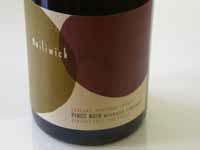 2011 Bailiwick Michaud Vineyard Chalone Monterey County Pinot Noir 13.7% alc., pH 3.66, TA 0.65, 100 cases, $38. Sourced from a unique vineyard located at 1600 feet elevation at the front door of the Pinnacles National Monument. This vineyard is one of the only places where decomposed granite and limestone are present at the surface. Noted winemaker and vineyardist Michael Michaud tends the vineyard. Clones 115, 667, 777 and Swan. 100% de-stemmed, macerated on the skins for several weeks post-fermentation, and aged 17 months in 45% new French oak barrels. · Moderately light reddishpurple color in the glass. Haunting aromas of dark cherries and clove spice. Tasty core of well-spiced strawberry and cherry fruits. Light in weight but flavorful, with a modestly firm tannic backbone and a pleasing finish. Score: 89
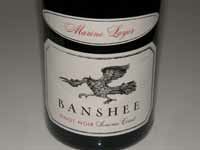 2011 Banshee Marine Layer Sonoma Coast Pinot Noir 13.7% alc., 100 cases, $45. A blend from four sources. Aged 15 months in 20% new French oak barrels. · Moderate reddish-purple color in the glass. This is a perfect example of the challenge of reviewing Pinot Noir. After opening, the wine was good but not great, but when tasted the following day from a previously opened and re-corked bottle, the wine had become considerably more expressive and nuanced. The bright fruit aromas of Bing cherry, blueberry and spicy red raspberry combined with a hint of red rose petals is very enticing. Modest in concentration but big on flavor, the wine shows off a juicy core of dark red cherries and berries caressed by soft tannins. The underlying acidity brings vibrancy to the palate and finish. A refined wine with style and grace. Score: 90
2012 Belle Glos Clark & Telephone Santa Maria Valley Pinot Noir 14.6% alc., $44. Own-rooted Martini clone planted in 1972. Aged 9 months in 60% new French oak barrels. · Dark, deep violet color in the glass. This wine is oak vanillin-infused through and through. Moderately rich and plush flavors of candied plum, blackberry, black raspberry, exotic chocolate and spice are framed by good acidity and caressing, velvety tannins. Seductively soft and smooth on the palate, the wine finishes with a persistent wealth of fruit and a touch of heat. Score: 87
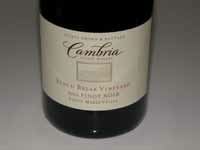 14.5% alc., pH 3.54, TA 0.60, 703 cases, $34. Sourced from four blocks that represent a structured fruit expression in contrast to the feminine qualities of the Julia’s Pinot Noir. Clones 667, 2A, 4, 23 and 115. Aged 10 months in 50% new French oak barrels. · Moderately dark reddish-purple robe in the glass. Aromas of oak-kissed black cherry, spice, new leather, anise, sweet smoke and ash. The full-bodied core of black cherry and blackberry fruit makes a statement on the mid palate and hangs on through a generous, long finish. The tannins are fine-grain and reserved and the mouth feel is quite smooth. The dark fruit is impressive, but is currently saddled with too much oak. The wine showed better the following day from a previously opened and re-tasted bottle. I would give this wine another year to allow the oak to better integrate. Score: 89
14.5% alc., pH 3.57, TA 0.65, 648 cases, $32. The Bench Break Chardonnay vines were planted in 1971 and a solo bottling first appeared in 1999. Clone is old vine clone 4. Aged 12 months sur lies with twice weekly stirring in 100% new French oak barrels. · Light golden yellow color and clear in the glass. The nose is appealing with scents of apple, citrus, straw bale, hazelnuts and brown butter. Slightly creamy on the palate with crisp, moderately rich flavors of lemon tart, green apple, lime zest, spice and vanilla. Score: 90
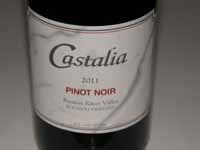 2011 Castalia Rochioli Vineyard Russian River Valley Pinot Noir 14.5% alc., pH 3.55, 300 cases, $55. I have been a long time fan of the Castalia Pinot Noirs produced from Rochioli Vineyard fruit by winemaker Terry Bering, the cellarmaster at Rochioli. This wine is 50% Rochioli River Block fruit and 50% from a 20-year-old block of Rochioli West Block selection planted in another vineyard on Westside and Rochioli Estate wine. Aged 15 months in 20% new French oak barrels. Terry told me his wines need time to evolve and I found this to be the case. I first tasted the wine last February and thought it was very good but not extraordinary then. My recent tasting found the wine had blossomed into something very special and it is certain to be one of my 2013 All-Americans. · Medium reddish-purple color in the glass. Alluring aromas of Bing cherries, strawberries, spice and musk which literally jump out of the glass over time. The flavor of cherry syrup caresses the palate with complimentary notes of spice and vanilla. The classy, lush fruit is perfectly buffered by ripe tannins and brought to life by bright acidity. The lengthy finish is simply gorgeous. Quintessential Russian River Valley richness, yet sleek, balanced and refined. Score: 96
The four 2011 Davis Family Vineyards Pinot Noirs were released at the beginning of October (including the Russian River Valley bottling which is not reviewed here). The wines took Gold Medals at the prestigious 2013 Sonoma County Harvest Wine Competition. After a 5-7 day cold soak, gentle punch downs were done over a 3-4 week fermentation in small, temperature controlled, open-top fermenters. All wines were fermented with native yeast and spent 14 months in tight grain selections of French oak of which 30% were new, 30% were 1- year-old and 30% were 2-year old. Most of the wine has been allocated to wine club members (who receive discounts and free shipping on the first six bottles), but you may still snag a bottle or two by contacting Annie Rambo at the winery (707-569-0171) or visiting www.daviswines.com.
2011 Davis Family Vineyards Horseshoe Bend Vineyard Russian River Valley Pinot Noir 14.1% alc., $50. This vineyard is situated on a ridge top at the crown of the sub region of the Russian River Valley known as Occcidental Ridge on the extreme western edge of the appellation. Elevation of the vineyard is about 1,200 feet, keeping it above the fog line on most days. This location enjoys much lower overall temperatures due to the coastal influence, yet has full sun exposure throughout the day. The result is small, concentrated clusters and dark rich color in every vintage. · Moderate reddish-purple color in the glass. Very fragrant and intoxicating upon opening with aromas of black cherries, spice, red licorice and oak. Deeply flavored black cherry core with accents of toasted oak, clove and cardamom spice and an earthy undertone. The chiseled tannins provide structural balance, the acidity is well integrated, and the juicy finish has notable intensity and persistence. Score: 91
2011 Davis Family Vineyards Starr Ridge Vineyard Russian River Valley Pinot Noir 14.1% alc., $50. This 20-year-old vineyard sits on the eastern edge of the Middle Reach sub region of the Russian River Valley. Soils are ancient Franciscan series, heavier decomposed volcanic rock and clays rich in iron. The site benefits from a combination of its warmer Middle Reach location and cooler east facing exposure. · Moderately dark reddish-purple color in the glass. Complex array of aromas including cherry, red berry, shoe leather and oak spice. Delicious essence of black cherry fruit in a modestly concentrated yet flavorful wine embellished with a welcome oak accent. Very smooth on the palate with supple tannins and a finish that goes on and on. I find I am consistently attracted to wines made from this vineyard. Score: 92
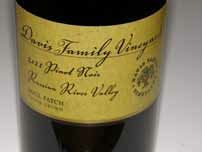 2011 Davis Family Vineyards Soul Patch Estate Grown Russian River Valley Pinot Noir 14.1% alc., $50. A barrel selection from the Estate Vineyard. A combination of Pommard, 777, 667 and 115 planted in 1996. Farming has always been organic. The vineyard is in the sub region of the Russian River Valley known as Laguna Ridge featuring Goldridge series soils containing a high amount of volcanic ash. · Moderately dark reddish-purple hue in the glass. Initially this wine is quite reserved and takes some coaxing in the glass to bring it into the open. Enticing aromas of Bing cherry, red berry, fruit cake, spice and sandalwood. Bold and intense with a meaty core of black cherry, black raspberry and blueberry fruits backed by complimentary oak. The luscious fruit is pulled into line with fine tannins and acidity. The finish deserves special mention as it is extraordinarily long and intense. The wine was much better the following day from a previously opened and re-corked bottle. In fact, it was so tasty you could nibble at it. Decant if you must drink now, but the wine will benefit from a few years in the cellar. It’s wines like this that make Pinot my paramour. Score: 94
2010 Dierberg Estate Grown Santa Maria Valley Pinot Noir 14.0% alc., pH 3.52, $44. Dierberg Vineyard is planted with 11 different Pinot Noir clones. Brix at harvest was 25º. Aged in 33% new French oak barrels for 18 months and bottled unfined and unfiltered. · Moderately dark reddish-purple color in the glass. Aromas and flavors of black cherry, black raspberry, black currant, spice, tea leaf and oak-driven accents of tobacco, toast and herbs. The tannins are well managed, the mouth feel is smooth and comforting, and the finish is clean and uplifting. A slight green pepper background note was evident in this wine. Score: 87
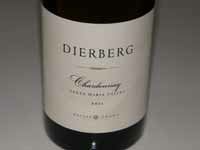 2011 Dierberg Estate Grown Santa Maria Valley Chardonnay 13.5% alc. pH 3.15, $32. The Dierberg Vineyard is situated on a sandy loam mesa above the South Bank of the Santa Maria River in the near-extreme Western part of the Santa Maria Valley AVA. This cool site combined with the sandy, marine-based soils, creates Chardonnay with high acidity. Brix at harvest was 24.5º. No skin contact. Primary fermentation was carried out in 400 liter barrels of which 25% were new. Less than 10% of the wine went through malolactic fermentation. The wine was age 10 months, racked from its lees, blended, lightly fined, unfiltered and bottled after harvest. · Light golden yellow color and clear in the glass. The nose is appealing with scents of apple, lemon, brown butter, nuts and straw bale. Smooth on the palate with very agreeable crisp flavors of lemon tart, green apple, and lime zest. There is a definite oak imprint which adds to the complexity. Score: 89
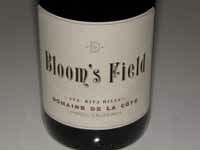 2011 Domaine De La Côte Estate Bloom’s Field Sta. Rita Hills Pinot Noir 12.5% alc., 360 cases, $55. The vineyard is 7.5 acres planted to three California heritage selections of Pinot Noir (Mount Eden, Swan and Calera). The name comes from the planting date of the vineyard which was Bloom’s Day (6/16/07). The clay topsoil is rich in iron and well-drained. The Pacific Ocean is 8 miles to the West so it is a cold microclimate. Typically, the clusters are very small with high levels of acidity. 90% whole cluster. Unfined and unfiltered. · Moderately dark reddish-purple color in the glass. This wine has the exotic perfume that can only come from whole cluster with waves of dark red and black berries, imported spices, and a floral whiff complimented by sweet oak. A delicious wine that makes you sit up and take notice of the plethora of plum, blueberry, black raspberry and pomegranate fruit supported by broad-shouldered tannins and bright acidity. Amazing sense of concentration despite the low alcohol level. The exhilarating finish seems to linger for half a minute. Even more enjoyable the following day from a previously opened and re-corked bottle. Score: 92
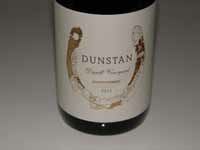 2011 Dunstan Durell Vineyard Sonoma Coast Chardonnay 13.3% alc., pH 3.50, TA 0.80, 318 cases, $45. Sourced from the Durell Vineyard 8.5-acre Ranch House Block planted in 2005 with 3.5-acres of old Wente selection with the balance to 5 different clones of Pinot Noir. 50% whole cluster and 50% destemmed old Wente Chardonnay aged 14 months in French oak barrels. Malolactic fermentation was inhibited at the end of primary fermentation. · Medium golden yellow color and clear in the glass. Very lovely nose offering effusive aromas of lemon, brioche, vanilla and spice. Beautifully composed and balanced with appealing flavors of lemon, baked apple, banana and oak spice offering good richness of flavor. The overall impression is one of freshness and crispness with a finish that is outright lip-smacking. Score: 93
2010 Jeff Gordon Cellars Leo Sonoma Coast Pinot Noir 14.5% alc., pH 3.60, TA 0.62, 124 cases, $56. Jeff and Ingrid Gordon dedicate this wine to their son Leo Benjamin, born in August of 2010. Jeff is a four-time NASCAR Cup Series Champion and long time wine enthusiast. Sourced from Cummings Vineyard just west of Santa Rosa and Archer Vineyard just west of Windsor. Aged 9 months in 30% new and 70% 2- and 3-year-old French oak barrels. Unfined and unfiltered. · Moderately dark reddish-purple color in the glass. The inviting aromatics feature aromas of blueberry, red plum, ripe strawberry, pine sap, spice and oak vanillin. Quite flavorful and easy to drink with a middleweight core of strawberry, cherry and blueberry fruits backed by juicy acidity and buffered by fine-grain tannins. Score: 89
2010 Highflyer Wines Santa Maria Valley Chardonnay 14.7% alc., 550 cases, $28. Sourced from lowyielding vines at Sierra Madre Vineyard located near the western edge of the Santa Maria Valley appellation. Winemaker and “pilot” is Craig Becker. Previously reviewed in April 2012 (that bottle showed better). · Moderate golden yellow color and clear in the glass. Aromas of lemon tart, buttered popcorn, lychee and haystack lead to flavors of lemon curd, banana, lychee, nuts and creamy pastry. Easy to drink with a slightly creamy texture and a refreshing cut of lemony acidity on the finish. Score: 86
2012 Santa Arcangeli Family Wines Split Rail Vineyard Santa Cruz Mountains Rosé of Pinot Noir 14.1% alc., pH 3.61, 50 cases, $25. A combination of David Bruce selection and UCD 32 (a traditional sparkling wine clone) from a vineyard in the southern part of the Santa Cruz Mountains known as Corralitos. Grapes were specifically selected for this wine (not a saignée), 100% de-stemmed, pressed off the skins after 24 hours. Fermented in neutral Ermitage oak barrels with indigenous and inoculated yeasts. Aged 7 months on the lees with monthly battonage. Racked once, cold stabilized and filtered for clarity at bottling. · Moderately deep pinkish-red color and clear in the glass. The nose offers the fresh scent of strawberry, rose petal, bark and nutty oak. The flavors of strawberry, cherry, red currant and oak spice are satisfying and persist on the dry finish which has a bite of acidity and a hint of heat. Score: 86
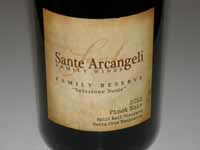 2012 Sante Arcangeli Family Reserve Split Rail Vineyard Santa Cruz Mountains Pinot Noir 14.1% alc.,pH 3.65, 75 cases, $40. David Bruce selection, UCD 23 (Roederer) clone and Pommard. Harvested at 23.5º Brix. 20% whole cluster. Fermented, cellared and bottled separately from other lots. 20% whole cluster. Aged on the lees 10 months in 60% new French oak barrels. Unfiltered. · Moderately light reddish-purple color in the glass. Inviting array of aromas including cherry, cranberry, potpourri, oak spice and cinnamon. A gentle, ethereal styled wine with enough cherry, sassafras and spice to satisfy. There is significant palate presence of oak but it is hard to complain about this polished, well-perfumed offering. Score: 90
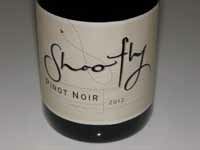 2012 Shoofly Yarra Valley Victoria Australia Pinot Noir 13.5% alc., pH 3.60, TA 0.59, $14 (retail but available for as little as $9.99), screw cap. Imported by Old Bridge Cellars, Napa, CA. This winery was founded in 2003 and is led by noted Australian winemaker Ben Riggs. 50% whole cluster. Aged 11 months in second-use oak barrels. · Medium reddish-purple color in the glass. Nicely perfumed initially with black cherries, dark raspberries and spice. Over time, the dark fruit recedes and oak comes to the forefront. The moderately intense flavors echo the aromas with modest smoky, tobacco oak highlights, and the appealing concentration is backed by crisp acidity. Very easy to drink, literally slipping off the back of the palate. A ridiculous value. Score: 88
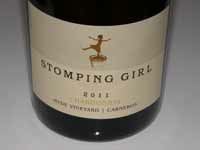 2011 Stomping Girl Hyde Vineyard Carneros Chardonnay 13.8% alc., pH 3.50, TA 0.60, 150cases, $40. First established in 1981, Hyde Vineyard is widely acclaimed. It is planted on gently rolling hills and cooled by wind and fog from nearby San Pablo Bay. The soils is well-drained ancient creek beds of clay loam and rocks. Clones are Wente Hyde Field selection and Robert Young hand harvested at 22.2º Brix just before the October rains. Whole cluster pressed, barrel fermented sur lie with regular stirring, 100% MLF, aged 11 months in 15% new French oak barrels and bottled unfined and unfiltered. · Mild yellow blonde color in the glass. The aromas of nectarine, lemon, Fuji apple and hazelnuts draw you into the glass. A very polished and sophisticated wine offering refined flavors of lemon, pineapple, green apple, and brine with a pleasing kiss of lemon on the finish. The wine’s underlying bright acidity supplies plenty of vibrancy. This wine has a Burgundian soul and reminds me of a William Fevre Les Clos Chablis Grand Cru that I recently drank. Score: 94
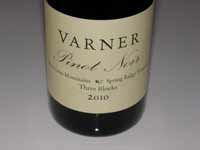 2011 Varner Spring Ridge Vineyard Three Blocks Santa Cruz Mountains Pinot Noir 14.6% alc., $40. · Medium reddish-purple color in the glass. There is some herbal and tobacco laced oak at play in this wine which features aromas of black cherry, spice, forest floor and smoke with mid weight flavors of black cherry, black raspberry, black currant, pepper and spice. A harmonious wine with modest tannins and energetic acidity, finishing with a welcome burst of aromatic cherry goodness. Even better later in the day from a previously opened and re-corked bottle. Score: 91
2011 WALT Blue Jay Anderson Valley Pinot Noir 15.2% alc., 1,875 cases, $40. Sourced from Hein, Savoy, Anderson Creek and other vineyards. Native yeast fermentation, unfined and unfiltered. · Moderate reddish-purple color in the glass. Lavishly perfumed with aromas of black raspberry jam, pepper, spice and oak with a very slight funky barnyard note. On the palate the wine is juicy and forward with flavors of dark red and black raspberries, black cherries, baking spices and seasoned oak. A discreetly concentrated offering with some finishing power. Score: 87
2011 WALT La Brisa Sonoma County Pinot Noir 14.8% alc., 1,051 cases, $40. La Brisa is Spanish for “The Breeze.” Sourced from multiple vineyards throughout the Russian River Valley including Widdoes, Martinelli, Gregori, and the Gap’s Crown in the Sonoma Coast. Native yeast fermentation, unfined and unfiltered. · Moderately dark reddish-purple color in the glass. Delicate aromas and flavors of Bing cherry, red berries and oak. Relatively light in weight but charming with soft tannins and some finishing length. A solid if not inspiring wine that displays plenty of oak imprint. Score: 88
Sips of Recently Tasted Oregon WinesBig Table Farm was a featured winery at the 2013 International Pinot Noir Celebration. The name of the winery is apropos since Brian and Claire continue to raise animals on their farm including calves and steers, pigs, laying hens, and horses, as well as set a big table for guests who visit. Big Table Farm is now leasing all 12 acres of the Wirtz Vineyard. 2012 will be the last vintage for Resonance Vineyard as that vineyard was purchased by Maison Louis Jadot who plan to use all the fruit for their own production. Kevin and Carla Chambers, who owned and farmed Resonance Vineyard, have acquired another property and are in the planning stages of planting a vineyard, so Big Table Farm should be able to work with them again in the future. Plans for a winery on the farm are complete. All vineyards in 2011 were picked at the very end of October and the sounds of trick or treaters filled the air as grapes were being sorted and processed. The wines are quite young and Brian recommends decanting if you open them now. I found that all the Pinot Noirs were at least as good or better two days after opening. All wines are unfined and unfiltered. A big plus with these wines is that because the alcohol percentages are low, you can easily enjoy a couple glasses without getting sideways. Each label is a work of art by Claire. Visit www.bigtablefarm for more information or sign up for the mailing list.
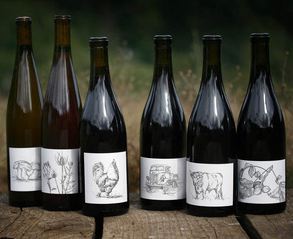
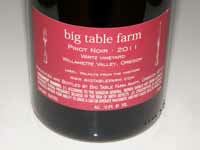 2011 Big Table Farm Wirtz Vineyard Willamette Valley Pinot Noir 12.6% alc., 119 cases, $45. This vineyard is old by Oregon standards as it was planted in the early 1970s. Brian likes to say he was still wearing diapers when the vines went into the ground in this vineyard. · Moderate reddish-purple color in the glass. This wine reminds of cherry pie baking day at cooking school. Deliciously flavored with ripe cherries and baking spices with a hint of sandalwood and wintergreen. Crisp and juicy with a long, spirited finish. Hard to put your finger on the reasons for it, but this wine grabs your interest and holds on. An old vine treasure. Score: 94
2011 Big Table Farm Sunnyside Vineyard Willamette Valley Pinot Noir 12.5% alc., 143 cases, $45. Inaugural vintage from this vineyard. · Moderately light reddish-purple color in the glass. Demure aromas and flavors featuring raspberry, dark cherry, white pepper, iron and a hint of smoky oak. Soft and dry in the mouth with a tangy cherry finish featuring zippy acidity. A wine with compelling modesty. Score: 89
2011 Big Table Farm Cattrall Brothers Vineyard Eola-Amity Hills Willamette Valley Pinot Noir 11.9% alc., 143 cases, $45. The highest elevation and coolest vineyard of the four wines in the 2011 Big Table Farm Pinot Noir portfolio. Fermented with native yeasts and whole cluster. · Moderately light reddish color in the glass. Shy, but pleasant aromas of cherries, red rose petals and oak plank. Elegant and delicate, with flavors of red cherries and berries, a hint of oak and herbs, and an acid-driven, refreshing finish. A bit dilute on the mid palate and finish, but overall a satisfying expression of the cool vintage. Score: 88
2011 Big Table Farm Resonance Vineyard Yamhill-Carlton Willamette Valley Pinot Noir 12.9% alc., 287 cases, $48. This vineyard is the warmest site in the Big Table Farm lineup. Typically this wine needs a few years to mature and this is evident in this vintage as well despite spending a year in barrel and a year in bottle. · Moderately deep reddish-purple color in the glass. A well-mannered wine with aromas of dark cherry, marionberry and spice that fill the glass. While the core of black cherry fruit is delicious now, the wine is relatively primary at this stage. Still, it is obviously a classy and sophisticated offering. The tannins are firm but balanced and the finish is juicy and well-endowed with grandiose fruit flavor. Hold for 2-3 years or decant if you must drink now. Score: 93-94
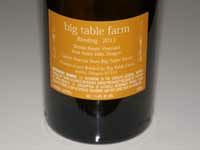 2011 Big Table Farm Brooks Estate Vineyard Eola-Amity Hills Willamette Valley Riesling 11.4% alc., 91 cases, $28. Barrel fermented to dryness with native yeasts and complete malolactic fermentation. · Moderate golden yellow color and slight haze (unfiltered) in the glass. Lovely aromas of lemon zest, wet stone, buttered brioche and paraffin. Very flavorful with pleasing notes of lemon and grapefruit with a touch of spice and a subtle petrol note. Slightly creamy in the mouth with a firm grip of lemony acidity on the bright finish. I don’t drink much Riesling, but I know a great one when I taste it. Score: 90
2011 Big Table Farm Wirtz Vineyard Willamette Valley Pinot Gris 13.8% alc., 115 cases, $32. An “orange wine” fermented on the skins briefly and then finished in barrel to dryness with complete malolactic fermentation, bottled without fining or filtration. · Medium red-orange color and clear in the glass. An unusual wine which is a challenge to describe. Aromas of peach skin, jasmine and eucalyptus. Soft and smooth on the palate with flavors of dried cherry, yellow peach and baking spice. Similar to Pinot Noir Blanc in its flavor profile. Mild dry tannins and hi-tone acidity, with a trace of heat on the finish. A conundrum. Score: 87
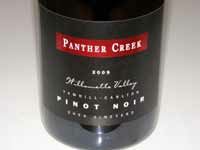 2009 Panther Creek Cellars Shea Vineyard Yamhill-Carlton Willamette Valley Pinot Noir 14.3% alc., 925 cases, $45. Current release. Willakenzie soils over fractured sandstone. Clones 114, 667, 777, Pommard and Wädenswil. Aged 16 months in 30% new and 70% neutral French oak barrels. · Moderate reddish-purple color in the glass. Aromas of black cherry, briar, cigar box and hickory are inviting. A generous wine with flavors of black cherry and black raspberry that fan out nicely on the palate, complimented by oak flavors that fold in nicely. The fruit is plush yet vibrant with an obvious esteemed pedigree. The wine aims to please with a generous burst of fruit on the finish. Score: 90
White Rose Estate Winery and Vineyard is producing some of the most interesting Pinot Noirs in Oregon. The wines are “neo-classical” as it states on the label, in that they are produced in the time-honored tradition of many great Burgundy wines using a significant amount of whole cluster that adds more secondary character to the wines and provides a fuller structure for a clear expression of flavor. Winemaker/owner Greg Sanders and winemaker Jesus Guillen or both self-taught, but they have a clear style in mind which has been fully implemented since the 2008 vintage. A number of tasters have likened the wines to those of Domaine Dujac, and I can’t argue with that. Some of the White Rose wines have been an epiphany for me. The White Rose Vineyard is 12 acres located in the southern part of the Dundee Hills at an elevation of 700 to 800 feet. The vines are self-rooted Pommard clone planted from 1978 to 1981 and Dijon 115 clone planted in 2001. The soil type is volcanic Jory series. In the 2011 vintage, all the wines reviewed below were fermented with whole cluster ranging from 75% to 100%. Total skin contact ranged from 22 to 26 days. All wines were basket pressed in a traditional wooden ratchet press and racked once after completion of malolactic fermentation. New oak ranged from 8% to 25%. All the wines display the enchanting whole cluster perfume, complex flavors, and a bold, yet silky smooth, tannin structure. Visit www.whiteroseestate.com.
2011 White Rose Estate Willamette Valley Oregon Pinot Noir 13.0% alc., pH 3.66, 583 cases, $40. A blend of 4 vineyards (White Rose Estate 32%, Vista Hills 32%, Marsh 24% and Luciole 12%) in three different Willamette Valley sub-appellations, both old and young vines, sedimentary and volcanic soils. Clones are Pommard and Dijon 777, 115, 114 and 667. 80% whole cluster on average. Aged 11 months in 10% new French oak barrels. · Moderately light reddish-purple color in the glass. Pleasing aromas of cherry pie and exotic whole cluster spice. Elegant, yet flavorful, featuring cherry fruit, whole cluster spice and a tangy, citrusdriven brisk finish. The dry tannins are slightly foreboding, and the wine lacks finishing length, but it remains quite inviting and I would be happy to drink this every day. An excellent introduction to the White Rose Estate style. Score: 89
2011 White Rose Estate Durant Vineyard Dundee Hills Oregon Pinot Noir 13.0% alc., 167 cases, $60. Vineyard was planted in 1994 to Dijon clone 114 in Jory soil. Harvested November 2, 2011. 90% whole cluster, aged 16 months in 14% new French oak barrels. · Moderately light reddish-purple color in the glass. Reserved aromas of dark red cherries and berries, wooded forest and spice. This wine has the most concentration and the darkest fruit of the 2011 wines tasted. The whole cluster influence is subtle and alluring. The dry tannins are evident, but are pure silk in texture producing a very round and smooth palate. A generous, long finish completes the picture. Score: 92
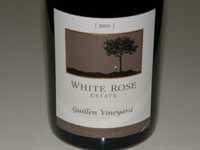 2011 White Rose Estate Guillen Vineyard Dundee Hills Oregon Pinot Noir 13.0% alc., 265 cases, $60. Vineyard planted in 2001 to Dijon clone 115 in Jory soil. Harvested November 6, 2011. 95% whole cluster. 6-day pre-fermentation maceration. Total skin contact 25 days. Aged 16 months in 18% new French oak barrels. · Moderately light ruby color in the glass. This wine shows the most whole cluster influence of any of the 2011 Pinot Noirs tasted on the nose and palate. The perfume is haunting with uplifting aromas of fresh cherry pie glaze, rose petals, leaf and exotic spices. Elegantly composed with a gentle core of cherry and cranberry fruits, a hint of oak, and plenty of whole cluster spice and forest floor. Broad-shouldered, dry tannins add structure and the juicy acidity lifts the tangy, cherry-themed finish. If you like whole cluster fermented Pinot Noir, you will flip over this wine. Score: 92
2011 White Rose Estate Anderson Family Vineyard Dundee Hills Oregon Pinot Noir 13.0% alc., 141 cases, $80. Self-rooted Dijon clone 115 planted in 1991 in Jory soil. Harvested October 28, 2011. Fermented 100% whole cluster. 3 days pre-fermentation maceration, total skin contact 23 days. Aged 16 months in 8% new French oak barrels. · Moderately light reddish-purple color in the glass. The nose opens slowly to reveal brilliant aromas of black cherry, whole cluster spice, rose petal and wine cave. Clean and pure on the palate with generous flavors of earthy cherry and strawberry with complimentary whole cluster spice. This wine has the most bold and muscular tannins of the 2011 wines tasted. Flavor intensity picks up over time in the glass which is always a good sign of longevity. Score: 93
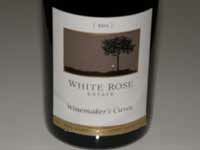 2011 White Rose Estate Winemaker’s Cuveé 13.0% alc., 99 cases, $85. Sourced from White Rose Vineyard and Luciole Vineyard. Pommard, 115 and 777 clones in Jory soil. Harvested November 4 (White Rose Vineyard) and November 1 (Luciole Vineyard). Fermented 75% whole cluster on average. 8 day pre-fermentation maceration, total skin contact 23.5 days. Aged 16 months in 25% new French oak barrels. · Moderately light reddish-purple color in the glass. The nose draws you into the glass with aromas of dark cherries, dried rose petal, exotic spice and a hint of smoke. Delicious from the get-go with a rush of spiced cherry and strawberry fruits on entry, penetrating every nook and cranny in the mouth, and finishing with uncommon grace and generosity. The spice is particularly evident on the finish. Despite the flavor onslaught, this wine remains elegant and refined. The healthy tannic structure predicts a long life ahead. A very special wine. Score: 94
Recently Tasted Chilean Pinot NoirChile is well known for its inexpensive red wine imports to the United States including blended reds and single varietal wines of Carmenère, Cabernet Sauvignon, Merlot, Syrah, Sauvignon Blanc, Riesling and Chardonnay. Less well known is the small cadre of Pinot Noir producers located in the Bio Bio, Casablanca, Calchagua, Leyda and San Antonio Valleys focusing on small production, quality-driven Pinot Noir. Chile followed the historical progression of California in that early plantings of Pinot Noir were located in the wrong places such as the Casablanca Valley floor which is quite warm. Vintners eventually discovered the best cool climate sites near the Pacific Ocean, similar to California’s Sonoma Coast. A number of producers have recruited consulting winemakers from the United States and France. Some well-known Chilean Pinot Noir producers include Cono Sur, Kingston Family Vineyards, Matetic Vineyards, Veramonte and Veranda Winery. Chilean wine regions are organized by valleys as shown in the map below.
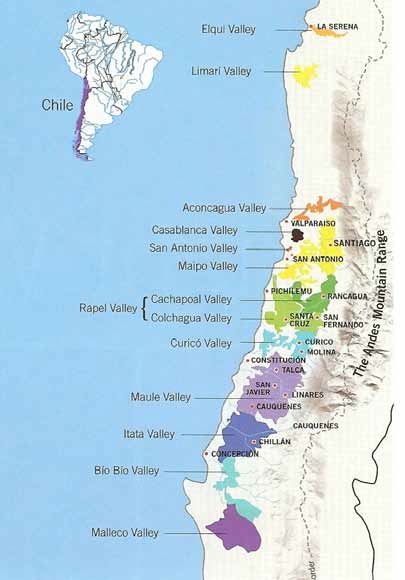 Damon Levy of Vine Connections, a leading importer of Argentine and Chilean wine, recently sent me four Chilean wines that are part of the new breed of cool-climate Pinot Noir from true coastal vineyards in Chile. I found two of the wines very enjoyable. All the wines showed a significant oak imprint which may or may not be to your taste. The wines are reasonably priced. Visit www.vineconnections.com for more information and availability. The map below shows the location in Chile of the wines reviewed.
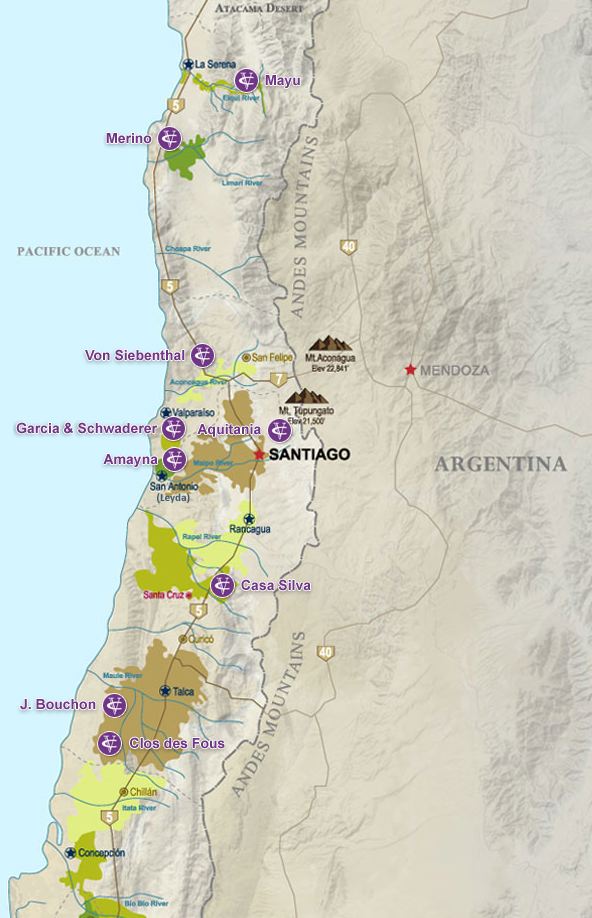
2010 Viña Aquitania Sol de Sol Traiguén (Malleco Valley) Chile Pinot Noir 12.5% alc. 300 cases, $35. Vineyard planted by Felipe de Solminihac, the first person to plant a vineyard in Malleco Valley. He began with Chardonnay in 1991 and added Pinot Noir 17 years ago. The winery’s Chardonnay is widely considered the best produced in South America. Average age of Pinot Noir vines is 8 years. Aged 12 months in some new French oak barrels. · Medium reddish-purple color in the glass. Shy nose showing rustic aromas of tobaccolaced oak and black cherries with slight reduction. The wine was decanted, but the nose still never came around. Mid weight flavors of black cherry and smoky oak with a hint of citrus-driven acidity on the dry, somewhat lengthy finish. Score: 85
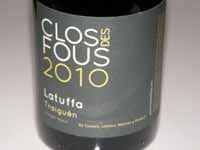 2010 Clos Des Fous Latuffa Traiguén (Malleco Valley) Chile Pinot Noir 14.0% alc., 250 cases (100 cases imported), $36. Malleco Valley is cold and rainy, reminiscent of the climate in the Willamette Valley. The soil is volcanic. Sourced from a vineyard which was an old experimental vineyard planted by the government and neglected until the Clos des Fous team started managing it. The Clos des Fous team is Pedro Parra (a world renowned soil scientist), Francois Massoc (a winemaker trained in Burgundy), Paco Leyton (vineyard manager), and Albert Cussen (their mentor and backer). · Moderately dark reddish-purple color in the glass. Nicely appointed nose with aromas of black cherry, black raspberry, smoky oaky, and baking spices including clove. The discreetly concentrated flavors of darker stone fruits and berries are intriguing. Hints of chocolate and spice add interest. Plenty of oak character is featured, but the wine has good Pinotosity and admirable delicacy. Score: 89
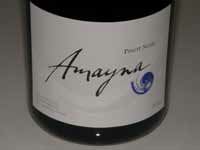 2011 Amayna Leyda San Antonio Valley Estate Bottled Chile Pinot Noir 500 cases, $35. Vinified by the Garces-Silva family whose vineyards are just 6 miles from the Pacific Ocean. Vineyards were planted in 1999 and 2000. The Garces-Silva family pioneered boutique estate wines from Leyda. Leyda Valley is slightly warmer than the coastal areas of Casablanca, but still possesses a cold climate compared to the central valley zones of Chile. The name, Amayna, loosely translates to the calm on the water or the calm before a storm and the Garces-Silva family used this name because the vineyard reminded them of that sensation and its proximity to the ocean. Aged in some new oak for 12 months. · Moderately dark reddish-purple hue in the glass. Inviting array of black fruit aromas on the nose with hints of oak-driven coffee and roasted nuts. Very Caliesque in character with rich, sappy flavors of black raspberry, purple plum and dark chocolate with a modest oak overlay. Very plush, lush and velvety on the palate with strong finishing intensity. The wine is said to have a saline quality due to its proximity to the ocean, but I was hard pressed to discover this because of the prodigious fruit. A bit decadent for my taste, but everyone needs a little debauchery once in a while. Score: 90
2012 Boya Leyda San Antonio Valley Chile Pinot Noir 13.0% alc., 1,500 cases, $22, screw cap. Also produced by the Garces-Silva family but from sections of the vineyard that are harvested earlier. Average age of vines is 4 years. Aged 6 months in third use French oak barrels. · Medium reddish-purple color in the glass. Unpleasant aromas of stem, grass, and green pepper. On the palate, delicate red cherry and berry flavors are featured underlain with a significant green herb and green bell pepper riff. Juicy, with nice balance and finesse, but the unripe, vegetal flavors spoil the experience. Score: 82
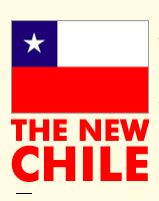
Pinot BriefsWine vs. Beer Web journalist Alex Hillsberg sent me an interesting article containing relatively unknown facts of interest to wine and beer enthusiasts: www.financesonline.com/beer-vs-wine/. Did you know that the world’s second best selling wine brand in 2012 was China’s Great Wall, the third most popular wine sold in the U.S. by the glass is Pinot Noir, and that the Czech Republic drinks the most beer in the world (the U.S. is #15 among worldwide countries)? Glowing Reports on California’s 2013 Vintage Monterey County’s Arroyo Seco AVA has wrapped up an ideal harvest that will go down as one of the region’s best. The growing season was dry and mild which limited shatter and yields and provided even ripening. Cool weather in July and August led to extra hang time and good acidity. There were no heat spikes during the growing season. It was a sleepless harvest in the Russian River Valley as growers picked earlier than last year. The harvest was very rapid and compressed with good tonnages that were held in checked by thinning. Cooler temperatures in August slowed the pace of grape ripening, allowing more time for fruit to mature on the vines. September rains were challenging, but overall grape quality, particularly for Pinot Noir and Zinfandel was outstanding. Lane Tanner has New Wine Label Noted veteran Central Coast Pinot Noir vintner, Lane Tanner, has a new wine label - Lumen - and a new partner - Will Henry. The inaugural wine is a Grenache crafted in her inimitable Pinot Noir style. Visit www.lumenwines.com. Sensorist Debuts New Instrument/Gadget for Wine Enthusiasts The system consists of a gateway that is connected to your home network and from there to the internet, a wireless sensor and a wine bottle probe. The probe is equipped with a cork so it can be inserted into a wine bottle filled with water and placed where you store your wine. The probe will record the bottle temperature and humidity, enabling one to see differences when the surrounding environment changes. The system is totally wireless and long range so that you can monitor your wine if your are not at home or close to your wine both on the Sensorist website and via an iPhone App. Sensorist monitors daily temperature variations, the humidity of the environment you wine is stored in and alerts you if the cooling system is not operating at the desired temperature. The system supports more than 200 sensors which you can buy anytime. A package for wine enthusiasts consists of a gateway, 2 sensors and a wine bottle probe sells for around $180. Learn more by visiting www.sensorist.com.
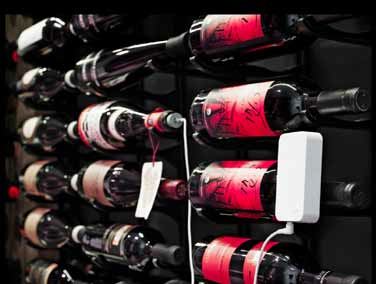 Triple Creek Ranch Vintner Events Triple Creek Ranch in Darby, Montana, is a recipient of Travel- Leisure magazine World’s Best Award and 2012 World’s Best Service Award. Five 4-day Vintner Events are planned at Triple Creek Ranch for 2014 each featuring a different vintner: Merry Edwards, Ehren Jordan and Anne-Marie Failla, Cyril and Blakesley Chappellet, Howard Mozeico and Jessica Mozeico-Blair of Et Fille, and Lynn and Ron Penner-Ash. For information, visit www.triplecreekranch.com. Marlborough Pinot Noir Rising Read the article by Curtis Marsh who joined a group of Marlborough winegrowers and international wine writers for a trekking adventure with a 4WD coined “The Marlborough Pinot Noir Safari,” The escapade took the group into the hills of the Awatere and Southern Valleys and through the back country routes of Awatere, Brancott, Omaka and Waihopai valleys where they discovered the special sites that are putting Marlborough Pinot Noir on the map. Visit www.thewanderingpalate.com/new-world-pinot-noir/ marlborough-pinot-noir-rising/. Scratch & Sniff Wine Guide Master Sommelier Richard Betts has written a humorous book that removes wine pretentiousness and substitutes easily understood text, simple language and many explanatory illustrations. There are sixteen scent stickers in the book that allow the reader to interact and smell different elements in wine. A fold out aroma wheel breaks down wines by grape, region and style. An introductory but comprehensive book primarily intended for novices although it can appeal to wine enthusiasts at all levels of expertise. $12.
 Recent Pinot Noir Tasting Revealed Preference for Less The St. Helena Star and Napa Valley Vintners Tasting Panel reviewed 21 Napa Valley Pinot Noirs from the 2009 to 2012 vintages. As reported in The Drinks Business at www.thedrinksbusiness.com, panelists wanted less extraction, alcohol and oak flavors in Pinot Noir although Napa Valley producers seem to favor deeply colored, extracted and welloaked styles. Three producers who make the preferred “less is more” style were Ceja, Sinskey and Saintsbury, all located in the Carneros region where most of Napa Valley’s 3,000 acres of Pinot Noir are planted. Read the entire article at www.thedrinksbusiness.com/2013/10/napas-less-is-more-pinot-noirs/. Breathometer added to Smartphone-Based Breath Analyzer Offerings Originally featured on the TV show Shark Tank, the Breathometer has now been put into production. Like competitors Floome and Alcohoot, it plugs into a smartphone’s audio jack and connects to an App that can read blood alcohol concentration when one breathes into the key-sized reader. The Breathometer is $50 (money well spent) and is currently available for pre-order. It works with iOS devices that run iOS 7 and Android devices running version 2.3 and above. Visit www.breathometer.com.
 Short Film on Winemaker Matt Dees of Jonata A movie has been recently produced on Matt Dees commenting about what it is to be a winemaker in California and his love affair with wine grapes. The movie goes live on Monday, October 28, at www.cdsavoia.com/#/artists/matt-dees. French Government Proposes Further Restrictions on Wine The latest online Wine Spectator post (October 22), discusses a bill that the French Senate is considering that would increase the sin taxes on wine and require wine labels to carry the statement, “Alcohol is dangerous to your health.” It is already forbidden in France for journalists to praise a wine too much and the new bill would have extended that restriction to Facebook or Twitter (this part of the bill was later removed). The bill is being supported by the National Association for the Prevention of Alcoholism and Addiction and opposed by French vignerons. 2013 Sonoma County Harvest Fair Wine Awards - Pinot Noir Retail Price up to $24.99 (20 entries): Best of Class - 2012 Shiloh Road Sonoma County $17.95; Double Gold - 2012 Sebastiani Sonoma Coast $19.00; Gold - 2012 Folie a Deux Sonoma County $20.00, 2009 Karah Estate Vineyard Sonoma Coast $16.00, 2011 MacMurray Ranch Russian River Valley $24.00, 2012 Main & Geary Sonoma Coast $24.95, and 2012 Shiloh Road. - Pinot Noir Retail Prince $25 to $39.99 (52 entries): Best of Class - 2011 Sequana Russian River Valley $38.00; Gold - 2009 Bennett Valley Cellars Bennett Valley $38.00, 2011 Elipsis Wine Company DLM Vineyard “Tina’s Block” $34.99, 2012 Hook & Ladder “Third Alarm” Russian River Valley Estate Reserve $35.00, 2010 Roth Estate Sonoma Coast $28.00, and 2011 Sequana. - Pinot Noir Retail Price $40 and Over (63 entries): Best of Class - 2011 Davis Bynum Winery Jane’s Vineyard Russian River Valley $40.00; Double Gold - 2010 B.R. Cohn Russian River Valley $40.00, 2011 Matrix Buoncristiani Vineyard Reserve Russian River Valley $48, 2011 TR Elliott Russian River Valley $44.00; Gold - 2012 Balletto BCD Vineyard Russian River Valley Estate $42.00, 2012 Balletto Sexton Hill Vineyard Russian River Valley $42.00, 2011 Benziger Family de Coelo Quintus Sonoma Coast $75.00, 2011 Davis Family Vineyards Russian River Valley $45.00, 2011 Davis Family Vineyards Starr Ridge Russian River Valley $50.00, 2011 Davis Family Vineyards Soul Patch Russian River Valley $50.00, 2010 DeLoach Vineyards Green Valley $45.00, 2010 DeLoach Vineyards Van Der Kamp Russian River Valley $48.00, 2010 En Garde Russian River Valley Reserve $58.00, 2011 Matrix Nunes Vineyard Russian River Valley $42.00, 2011 Matrix Nunes Vineyard Reserve $56.00, 2009 Richard Berridge Sonoma Mountain $45.00, 2010 Rodney Strong Vineyards Russian River Valley Reserve $40.00, 2010 Thirty-Seven Sonoma Coast $40.00, 2011 Willowbrook Russian River Valley Estate $42.00, and 2010 Woodenhead Russian River Valley $52.00. CPR Enlivens Pinot Noir I reported in Pinot Briefs in August (www.princeofpinot.com/article/1404/) that the Tasmanian Institute of Agriculture has found that Pinot Noir wines that are microwaved and then fermented without skin contact resulted in wines that had high levels of aromas compounds that are responsible for cherry and chocolate aromas in wine. The process, called “controlled phenolic release,” or CPR, uses microwaves to extract grape skins and juice, decreasing the traditional maceration process. The longer the microwave exposure, the more depth of color and tannin level is achieved. In essence, CPR produces a more efficient release of tannins, phenolics and anthocyanins that maceration and there may be less chance of extracting harsh tannins. CPR also sanitizes the must, removing background yeast and bacteria. A recent post online from the Wine Spectator (October 23, 2013), offered more details on this new technology. Visit www.winespectator.com/webfeature/show/id/49105. As this article points out, there is still considerable work to be done and it is not clear what the impact will be on flavor. |